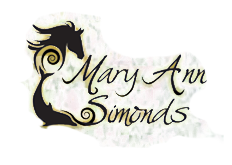Mary Ann Simonds
THE IMPORTANCE OF SMELL IN HORSES
Horses have a sophisticated sense of smell, far beyond that of humans. Horses use smell like we use speech, gaining information from their environment, their friends, their sexual partners, and to identify food and water. Smell may be the most important sense to a horse, as it takes up the largest part of the horse’s brain in neurological communications.
Smell is the primary sense used in social recognition and social bonding. Eye contact is first initiated, then a careful series of nostrilto – nostril blows and sensing, often then followed by vocalization and a stomp or physical contact such as a buddy scratch. Stallions often use smell, sensing which may or many not initiate a challenge versus a friendship. But smell and “nose bumps” (touch) are key in virtually all equine social greetings.

When observing the role smell plays in interactions of wild horses, it’s astonishing how, for example, blind horses can survive using mostly smell and touch or how a group of stallions could not hear or see a helicopter almost land on them as they were too occupied smelling mare urine. A wild horse could smell another horse’s manure and determine if they were male or female, friend or foe, what they ate and how much water they had drunk. This key information often allowed the horses to make decisions in new territories as to where to find water or food.
Although smell sensitivity in horses can vary depending on the horse—what nutrients it may be missing or whether a tight noseband has damaged its ability to smell—horses primarily use smell to search for food in domestic life. Free of most predators, however, a horse may refuse to load on a trailer that does not smell safe because it is too clean. One solution is to add some of your horse’s manure or its friends’ manure to the trailer. Or, maybe your horse has become “spooky” because it smells something that it associates with worry—or even a trauma—like in the case of the racehorse who would not come out of its stall on race day because the trainer would wear aftershave the horse did not like the smell. Nix the lotion and the horse went back to normal.
Mary Ann Simonds
Mary Ann has integrated her academic degrees in equine and human behavioral psychology and ecology with her equestrian background, working professionally for over 35 years in the horse industry. She grew up in California showing jumpers, and then attended the University of California and University of Wyoming to study the social ecology, behavior, and biology of wild horses. Realizing the need for higher education in our horse industry, Mary Ann founded the Whole Horses & Equestrian Science Institute in 1985 while brokering Sport Horses to bring more science of horses as a species into the horse world. Later, she received her master’s degree studying the interactions and relationships of horses and people helping to define the fields of Interspecies and Equestrian Psychology. She serves as scientific advisor for several equine non-profits and was an appointed member of the 1990 Federal Wild Horse and Burro Advisory Board. With one foot in the world of science and the other in the world of horses, Mary Ann acts a bridge and often is referred to as the “missing piece” for horsemen. She has developed a line of stress management and therapeutic products for horses including conducting research on magnetic field therapy and vibrational medicine in the late 1980s. A speaker, author, producer, equestrian, clinician, coach and horse lover, Mary Ann is passionate about educating others to better understand the real nature and culture of horses in an effort to limit stress in horses, ultimately improving performance and cooperation.
